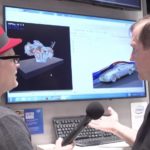Unlocking the bigger-picture meaning from raw data volumes is no easy task. Unfortunately, that means that many important insights remain hidden within the untapped data which quietly floods data centers around the globe each day. Today’s advanced applications require faster and increasingly powerful hardware and storage technologies to make sense of the data deluge. Intel seeks to address this critical trend with a new class of future Intel® Xeon® Scalable processors, code-named Cascade Lake.
New Class of Intel Xeon Scalable Processors Break Through Performance Bottlenecks
HPC and AI Convergence Take Center Stage for Intel at SC18
Intel has Big Plans at SC18 later this month, many of which are focused on HPC and AI convergence, and the intersections between these two sectors. “HPC is expanding beyond its traditional role of modeling and simulation to encompass visualization, analytics, and machine learning. Intel scientists and engineers will be available to discuss how to implement AI capabilities into your current HPC environments and demo how new, more powerful HPC platforms can be applied to meet your computational needs now and in the future.”
Cloud and Enterprise Adopting HPC-proven CPU-based Interactive, Photorealistic Rendering
The TACC Frontera supercomputer, which will become the fastest academic supercomputer in the United States when it becomes operational in 2019, will rely on CPUs for visualization. “The ability to run and visualize anywhere with SDVis solutions, regardless of the scale of the visualization task and without requiring specialized hardware for interactive response, is the reason HPC centers no longer need to procure GPUs for visualization clusters.”
Scale Your HPC Environment for AI Workloads
In this guest post, Intel Data Center Group’s Trish Damkroger covers how to scale your HPC environment for AI workloads. “Intel’s HPC interoperable framework assists developers with tools to modernize applications for advanced workloads and support for development languages like Python, C++, and Fortran.”
Exploring the Convergence of AI, HPC & More
This fall, the Intel Extreme Performance Users Group (IXPUG) will host a free conference focused on key high-performance computing, artificial intelligence, and cloud computing topics.This guest post from Intel explores how AI and HPC are converging and and how the two areas of technology — as well as cloud computing — are converging.
Growing HPC Adoption Among Manufacturers
The global manufacturing industry is moving down the path to a fourth industrial revolution — Industry 4.0 — empowered by the opportunity to collect and analyze massive amounts of data. This guest post from Intel explores how the global manufacturing industry is moving toward HPC adoption, and how it is approaching an inflection point which Intel refers to as “HPC for Everyone.”
Panel Discussion: The Convergence of AI and HPC
In this video from ISC 2018, Binay Ackalloor moderates a panel that explores the convergence of AI and HPC. “The next generation of supercomputers will provide scientists and researchers with powerful new tools to accelerate scientific discoveries and drive innovations. Intel is on the forefront of the convergence of artificial intelligence (AI), analytics, simulation and modeling and other HPC workloads that will drive the industry toward the next era in supercomputing.”
How Intel is Powering the Convergence of HPC & AI
In this video from ISC 2018, Binay Ackalloor from Intel describes how the company is powering the convergence of AI and HPC. “Artificial intelligence promises to transform more than just the way we do business – it will touch every corner of society. From using image recognition to enhance public security, to giving automated services a human touch with natural language processing, Intel Xeon processors are the foundation of today’s AI and tomorrow’s transformation.”
Announcing the next generation of Intel® Omni-Path fabric, Intel® OPA200
In this video from ISC 2018, Joe Yaworski from Intel describes how the newly announced Intel® Omni-Path fabric, Intel® OPA200 interconnect will speed up HPC and AI applications. “Intel shared at ISC its next-generation Omni-Path Architecture (Intel® OPA200), coming in 2019, which will provide data rate speeds up to 200 Gb/s, doubling the performance of the previous generation. This next-generation fabric will be interoperable and compatible with the current generation of Intel® OPA. Intel® OPA200’s high-performance capabilities and low-latency at scale will provide system architects the ability to scale to tens of thousands of nodes while benefiting from improved total cost of ownership.”
Announcing the new Intel Select Solution for Professional Visualization
In this video from ISC 2018, Jim Jeffers from Intel describes the new Intel Select Solution for Professional Visualization, an easily-deployed, Intel-optimized system reference architecture that is purpose-built to meet the demands of today’s most complex data explosion challenges. “”Visualization is a key component in advanced computing that allows systems to deliver greater insights with faster turnaround when using large-scale data sets.”













